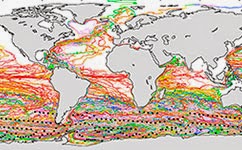
Adding iron to the Southern Ocean may not have the climate benefits that advocates of geoengineering have hoped for, a new study suggests.
The theory is to fertilise plankton so they absorb more carbon from the atmosphere and thereby slow down climate change. But researchers found that natural ocean circulation patterns mean most of the carbon probably wouldn’t stay put for long enough for a significant effect on the climate.
Simulations show that even if this method succeeds in absorbing carbon from the atmosphere and sinking it a kilometre beneath the Antarctic waters, currents may mean it only stays there for a few decades.
‘This adds to the evidence that iron fertilisation is never going to be the one solution to the problem of climate change, though there are still a few places it could be useful,’ says Josie Robinson, a PhD student at the University of Southampton and National Oceanography Centre and lead author of the paper, which appears in Geophysical Research Letters. ‘Even if all the problems that have already been pointed out with it were somehow solved, we’ve shown that ocean circulation will limit any benefits.’
Robinson and her co-authors used a high-resolution 3D model of ocean circulation to simulate the movement of carbon that had been added to the Southern Ocean around Antarctica over the course of a century. By the end of that time, two thirds of the carbon had returned to the surface – on average, it took just under 38 years, far less than would be needed for any real effect on the climate.
So-called ocean iron fertilisation (OIF) has been seen as a strong candidate for geoengineering – modifying some aspect of the land, ocean or atmosphere to soften the blow of global warming. It would involve feeding iron into parts of the ocean where its absence is the major factor limiting plankton growth – that is, where other vital nutrients are plentiful but iron is scarce.
Filling this gap could create huge blooms of plankton as these tiny marine plants feast on the sudden banquet, absorbing large amounts of carbon from the air. When the plankton die, would-be-geoengineers hope this carbon will sink down with their bodies and be trapped for millennia in the mud of the seabed, where it can’t affect the climate. The Southern Ocean is one of the biggest iron-deficient areas on Earth, so it’s been a popular candidate for iron fertilisation.
The idea seems plausible, but scientists have increasingly been asking tough questions. Some have pointed out that much of the carbon absorbed by the plankton won’t make it to the seabed; instead, it will decompose on the way down and come right back to the surface to be released to the atmosphere.
The new study goes one step further by looking at the problem from the perspective of a physical oceanographer rather than a marine biologist or biogeochemist. They started out from the assumption that these problems have been solved, so that carbon from a plankton bloom has somehow got down to a kilometre beneath the surface; they then asked how long it would stay there.
‘Other studies have looked at ocean circulation alongside marine biology, interactions between the sea surface and the atmosphere, and lots of other things,’ says Robinson. ‘We just concentrated on the ocean circulation, which meant we could use a much higher-resolution model than they could, and that gives us a much better understanding of how carbon would behave after reaching the deep ocean.’
It turns out that some of the very factors that make the Southern Ocean an attractive target for iron fertilisation also mean this probably wouldn’t have much lasting benefit. Water that’s rich in nutrients other than iron wells up here from the deep sea to the surface, and it’s this that means plankton only need a little iron to form large blooms. But these upwelling currents also pump deep carbon back into shallow waters where it can escape into the air.
Robinson says the research shows the importance of considering ocean circulation in assessing these kinds of proposal. ‘A lot of the discussion has centred on the Southern Ocean, but from a physical oceanographer’s point of view it’s about the worst possible place to hide carbon,’ she comments.
She adds that although the case for iron fertilisation in the Southern Ocean is weakened, the technique may still have some possibilities elsewhere – for example, the north Pacific is one potential target, with iron-poor waters and much less upwelling of water from the ocean depths.
An alternative option may be to move away from the idea of fertilisation with iron, focusing instead on adding other elements such as nitrogen or phosphorus to nutrient-poor waters where there’s very little upwelling and so a much better chance of keeping carbon down for long enough to have a significant effect on the climate. This could be more expensive than adding iron, but then letting climate change run rampant wouldn’t be cost-free either.
More information: “How deep is deep enough? Ocean iron fertilization and carbon sequestration in the Southern Ocean.” J. Robinson, E. E. Popova, A. Yool, M. Srokosz, R. S. Lampitt and J. R. Blundell. Geophysical Research Letters, Volume 41, Issue 7, pages 2489-2495, 16 April 2014. DOI: 10.1002/2013GL058799










